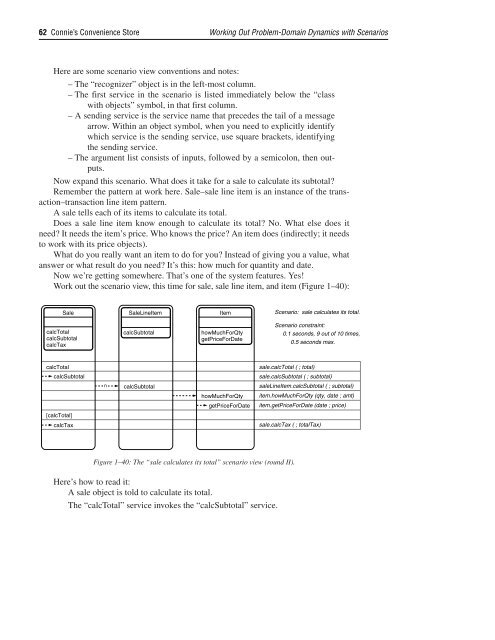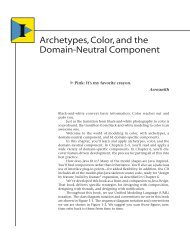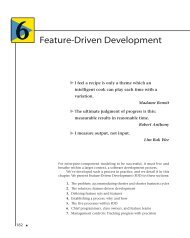Connie's Convenience Store - About Peter Coad
Connie's Convenience Store - About Peter Coad
Connie's Convenience Store - About Peter Coad
You also want an ePaper? Increase the reach of your titles
YUMPU automatically turns print PDFs into web optimized ePapers that Google loves.
62 Connie’s <strong>Convenience</strong> <strong>Store</strong> Working Out Problem-Domain Dynamics with Scenarios<br />
Here are some scenario view conventions and notes:<br />
– The “recognizer” object is in the left-most column.<br />
– The first service in the scenario is listed immediately below the “class<br />
with objects” symbol, in that first column.<br />
– A sending service is the service name that precedes the tail of a message<br />
arrow. Within an object symbol, when you need to explicitly identify<br />
which service is the sending service, use square brackets, identifying<br />
the sending service.<br />
– The argument list consists of inputs, followed by a semicolon, then outputs.<br />
Now expand this scenario. What does it take for a sale to calculate its subtotal?<br />
Remember the pattern at work here. Sale–sale line item is an instance of the transaction–transaction<br />
line item pattern.<br />
A sale tells each of its items to calculate its total.<br />
Does a sale line item know enough to calculate its total? No. What else does it<br />
need? It needs the item’s price. Who knows the price? An item does (indirectly; it needs<br />
to work with its price objects).<br />
What do you really want an item to do for you? Instead of giving you a value, what<br />
answer or what result do you need? It’s this: how much for quantity and date.<br />
Now we’re getting somewhere. That’s one of the system features. Yes!<br />
Work out the scenario view, this time for sale, sale line item, and item (Figure 1–40):<br />
Sale<br />
calcTotal<br />
calcSubtotal<br />
calcTax<br />
calcTotal<br />
calcSubtotal<br />
[calcTotal]<br />
calcTax<br />
n<br />
SaleLineItem<br />
calcSubtotal<br />
calcSubtotal<br />
howMuchForQty<br />
getPriceForDate<br />
Figure 1–40: The “sale calculates its total” scenario view (round II).<br />
Here’s how to read it:<br />
A sale object is told to calculate its total.<br />
The “calcTotal” service invokes the “calcSubtotal” service.<br />
Item<br />
howMuchForQty<br />
getPriceForDate<br />
Scenario: sale calculates its total.<br />
Scenario constraint:<br />
0.1 seconds, 9 out of 10 times,<br />
0.5 seconds max.<br />
sale.calcTotal ( ; total)<br />
sale.calcSubtotal ( ; subtotal)<br />
saleLineItem.calcSubtotal ( ; subtotal)<br />
item.howMuchForQty (qty, date ; amt)<br />
item.getPriceForDate (date ; price)<br />
sale.calcTax ( ; totalTax)




